Early Childhood Development: Optimizing Environment and Pedagogy
VerifiedAdded on 2023/05/30
|8
|2278
|232
Report
AI Summary
This report examines the critical role of the classroom physical environment and teacher pedagogy in shaping early childhood development, focusing on behavior, cognitive function, and social interactions. It analyzes a case study to identify factors within the physical environment, such as open spaces, colorful designs, and increased teacher attentiveness, that positively support children's learning and emotional well-being. The report also emphasizes the importance of effective teacher pedagogy, including child-centered teaching practices, collaboration skills, and cultural competence, to foster critical thinking, problem-solving, and social skills. Parental involvement and the use of game-based learning techniques are highlighted as strategies to enhance children's comfort, engagement, and cognitive development. Ultimately, the report advocates for a holistic approach that considers both the physical environment and teacher pedagogy to optimize early childhood development.

Running head: EARLY CHILDHOOD DEVELOPMENT
Early childhood development
Name of the student:
Name of the university:
Author note:
Early childhood development
Name of the student:
Name of the university:
Author note:
Paraphrase This Document
Need a fresh take? Get an instant paraphrase of this document with our AI Paraphraser
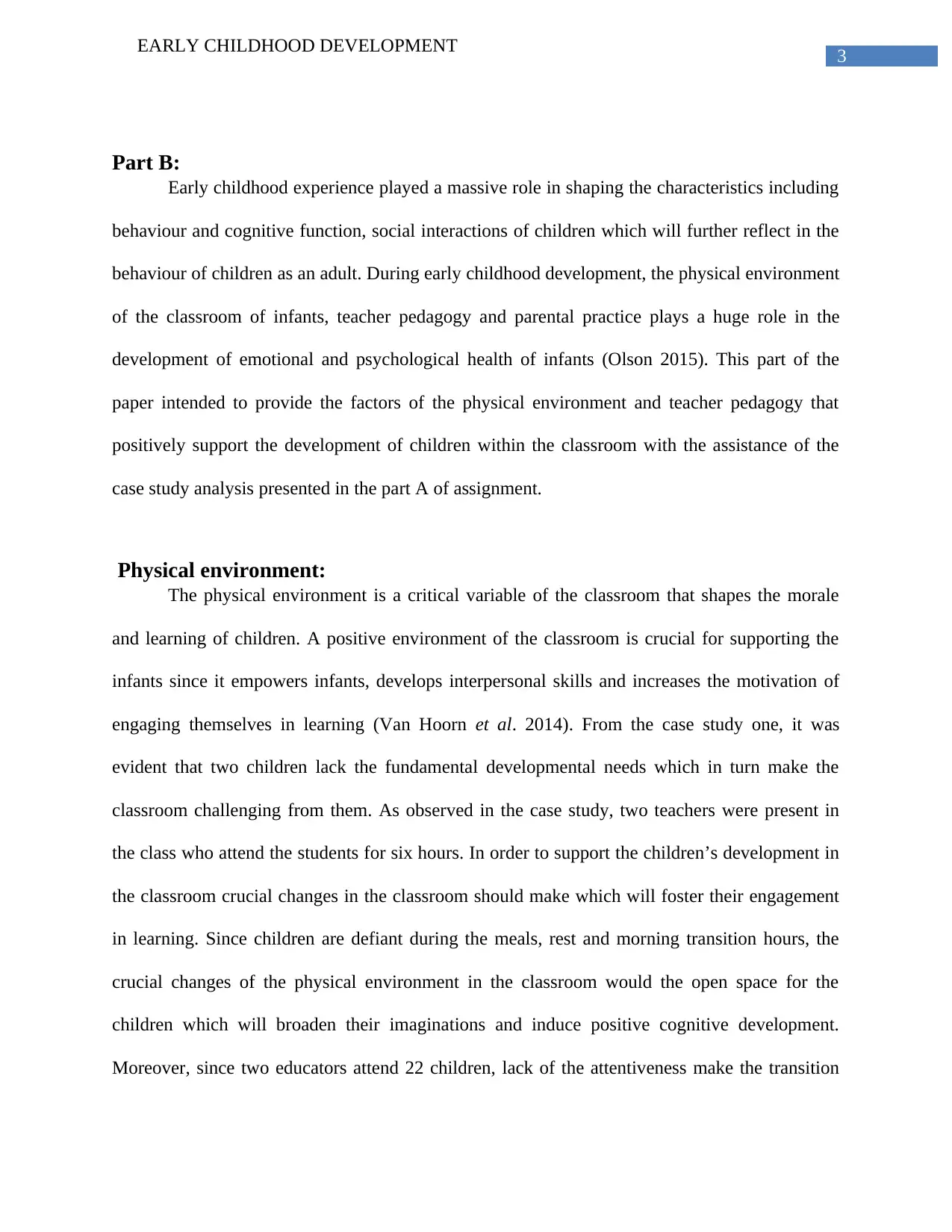
3
EARLY CHILDHOOD DEVELOPMENT
Part B:
Early childhood experience played a massive role in shaping the characteristics including
behaviour and cognitive function, social interactions of children which will further reflect in the
behaviour of children as an adult. During early childhood development, the physical environment
of the classroom of infants, teacher pedagogy and parental practice plays a huge role in the
development of emotional and psychological health of infants (Olson 2015). This part of the
paper intended to provide the factors of the physical environment and teacher pedagogy that
positively support the development of children within the classroom with the assistance of the
case study analysis presented in the part A of assignment.
Physical environment:
The physical environment is a critical variable of the classroom that shapes the morale
and learning of children. A positive environment of the classroom is crucial for supporting the
infants since it empowers infants, develops interpersonal skills and increases the motivation of
engaging themselves in learning (Van Hoorn et al. 2014). From the case study one, it was
evident that two children lack the fundamental developmental needs which in turn make the
classroom challenging from them. As observed in the case study, two teachers were present in
the class who attend the students for six hours. In order to support the children’s development in
the classroom crucial changes in the classroom should make which will foster their engagement
in learning. Since children are defiant during the meals, rest and morning transition hours, the
crucial changes of the physical environment in the classroom would the open space for the
children which will broaden their imaginations and induce positive cognitive development.
Moreover, since two educators attend 22 children, lack of the attentiveness make the transition
EARLY CHILDHOOD DEVELOPMENT
Part B:
Early childhood experience played a massive role in shaping the characteristics including
behaviour and cognitive function, social interactions of children which will further reflect in the
behaviour of children as an adult. During early childhood development, the physical environment
of the classroom of infants, teacher pedagogy and parental practice plays a huge role in the
development of emotional and psychological health of infants (Olson 2015). This part of the
paper intended to provide the factors of the physical environment and teacher pedagogy that
positively support the development of children within the classroom with the assistance of the
case study analysis presented in the part A of assignment.
Physical environment:
The physical environment is a critical variable of the classroom that shapes the morale
and learning of children. A positive environment of the classroom is crucial for supporting the
infants since it empowers infants, develops interpersonal skills and increases the motivation of
engaging themselves in learning (Van Hoorn et al. 2014). From the case study one, it was
evident that two children lack the fundamental developmental needs which in turn make the
classroom challenging from them. As observed in the case study, two teachers were present in
the class who attend the students for six hours. In order to support the children’s development in
the classroom crucial changes in the classroom should make which will foster their engagement
in learning. Since children are defiant during the meals, rest and morning transition hours, the
crucial changes of the physical environment in the classroom would the open space for the
children which will broaden their imaginations and induce positive cognitive development.
Moreover, since two educators attend 22 children, lack of the attentiveness make the transition
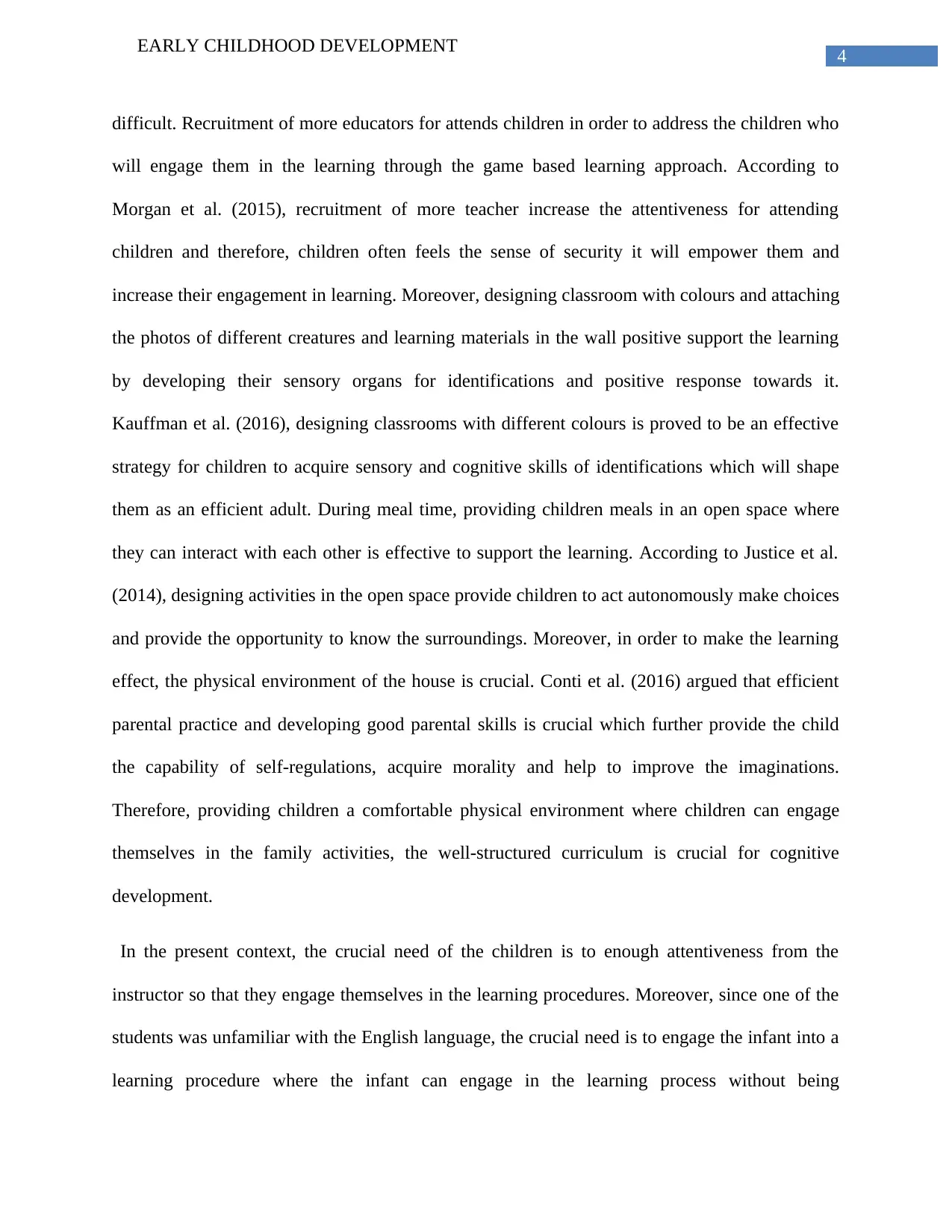
4
EARLY CHILDHOOD DEVELOPMENT
difficult. Recruitment of more educators for attends children in order to address the children who
will engage them in the learning through the game based learning approach. According to
Morgan et al. (2015), recruitment of more teacher increase the attentiveness for attending
children and therefore, children often feels the sense of security it will empower them and
increase their engagement in learning. Moreover, designing classroom with colours and attaching
the photos of different creatures and learning materials in the wall positive support the learning
by developing their sensory organs for identifications and positive response towards it.
Kauffman et al. (2016), designing classrooms with different colours is proved to be an effective
strategy for children to acquire sensory and cognitive skills of identifications which will shape
them as an efficient adult. During meal time, providing children meals in an open space where
they can interact with each other is effective to support the learning. According to Justice et al.
(2014), designing activities in the open space provide children to act autonomously make choices
and provide the opportunity to know the surroundings. Moreover, in order to make the learning
effect, the physical environment of the house is crucial. Conti et al. (2016) argued that efficient
parental practice and developing good parental skills is crucial which further provide the child
the capability of self-regulations, acquire morality and help to improve the imaginations.
Therefore, providing children a comfortable physical environment where children can engage
themselves in the family activities, the well-structured curriculum is crucial for cognitive
development.
In the present context, the crucial need of the children is to enough attentiveness from the
instructor so that they engage themselves in the learning procedures. Moreover, since one of the
students was unfamiliar with the English language, the crucial need is to engage the infant into a
learning procedure where the infant can engage in the learning process without being
EARLY CHILDHOOD DEVELOPMENT
difficult. Recruitment of more educators for attends children in order to address the children who
will engage them in the learning through the game based learning approach. According to
Morgan et al. (2015), recruitment of more teacher increase the attentiveness for attending
children and therefore, children often feels the sense of security it will empower them and
increase their engagement in learning. Moreover, designing classroom with colours and attaching
the photos of different creatures and learning materials in the wall positive support the learning
by developing their sensory organs for identifications and positive response towards it.
Kauffman et al. (2016), designing classrooms with different colours is proved to be an effective
strategy for children to acquire sensory and cognitive skills of identifications which will shape
them as an efficient adult. During meal time, providing children meals in an open space where
they can interact with each other is effective to support the learning. According to Justice et al.
(2014), designing activities in the open space provide children to act autonomously make choices
and provide the opportunity to know the surroundings. Moreover, in order to make the learning
effect, the physical environment of the house is crucial. Conti et al. (2016) argued that efficient
parental practice and developing good parental skills is crucial which further provide the child
the capability of self-regulations, acquire morality and help to improve the imaginations.
Therefore, providing children a comfortable physical environment where children can engage
themselves in the family activities, the well-structured curriculum is crucial for cognitive
development.
In the present context, the crucial need of the children is to enough attentiveness from the
instructor so that they engage themselves in the learning procedures. Moreover, since one of the
students was unfamiliar with the English language, the crucial need is to engage the infant into a
learning procedure where the infant can engage in the learning process without being
⊘ This is a preview!⊘
Do you want full access?
Subscribe today to unlock all pages.

Trusted by 1+ million students worldwide
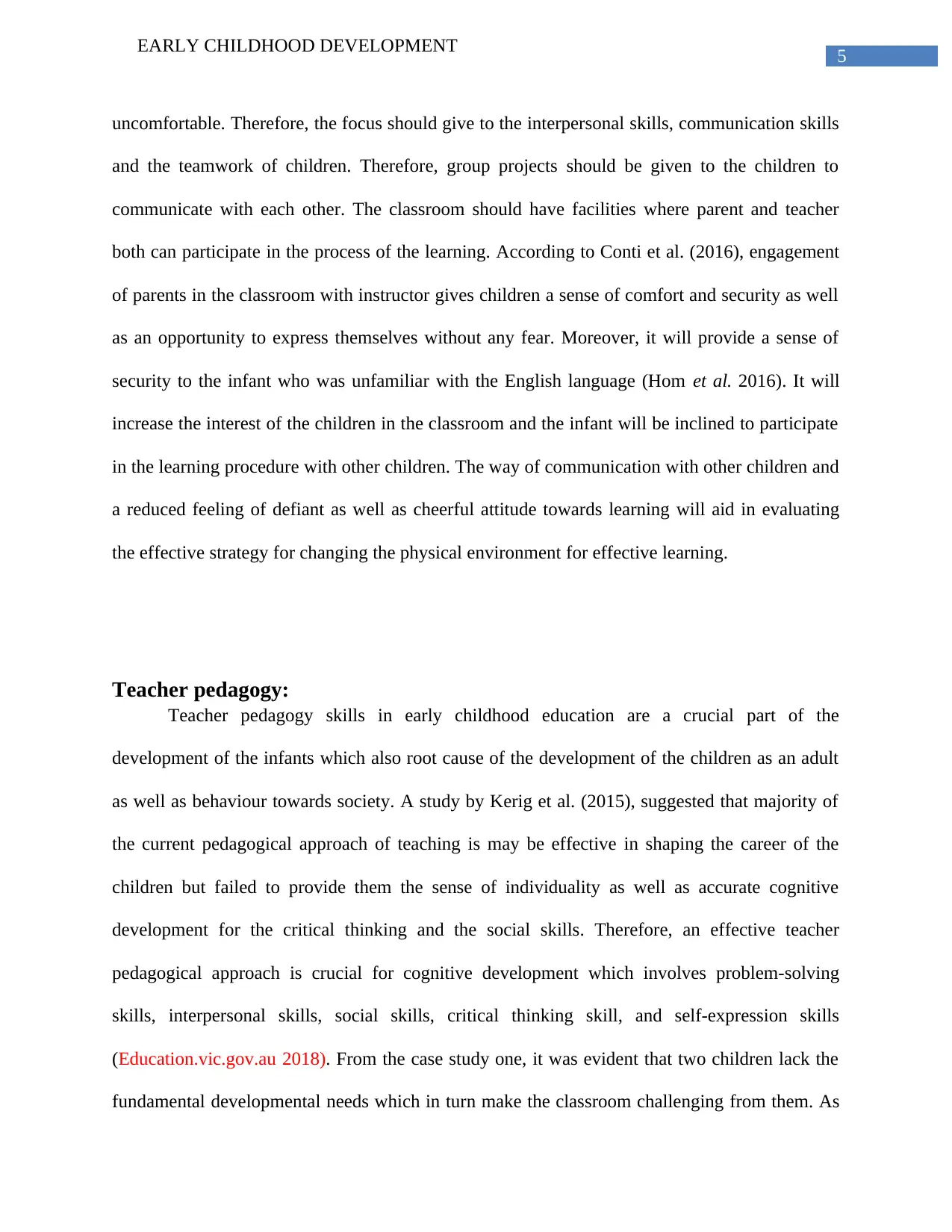
5
EARLY CHILDHOOD DEVELOPMENT
uncomfortable. Therefore, the focus should give to the interpersonal skills, communication skills
and the teamwork of children. Therefore, group projects should be given to the children to
communicate with each other. The classroom should have facilities where parent and teacher
both can participate in the process of the learning. According to Conti et al. (2016), engagement
of parents in the classroom with instructor gives children a sense of comfort and security as well
as an opportunity to express themselves without any fear. Moreover, it will provide a sense of
security to the infant who was unfamiliar with the English language (Hom et al. 2016). It will
increase the interest of the children in the classroom and the infant will be inclined to participate
in the learning procedure with other children. The way of communication with other children and
a reduced feeling of defiant as well as cheerful attitude towards learning will aid in evaluating
the effective strategy for changing the physical environment for effective learning.
Teacher pedagogy:
Teacher pedagogy skills in early childhood education are a crucial part of the
development of the infants which also root cause of the development of the children as an adult
as well as behaviour towards society. A study by Kerig et al. (2015), suggested that majority of
the current pedagogical approach of teaching is may be effective in shaping the career of the
children but failed to provide them the sense of individuality as well as accurate cognitive
development for the critical thinking and the social skills. Therefore, an effective teacher
pedagogical approach is crucial for cognitive development which involves problem-solving
skills, interpersonal skills, social skills, critical thinking skill, and self-expression skills
(Education.vic.gov.au 2018). From the case study one, it was evident that two children lack the
fundamental developmental needs which in turn make the classroom challenging from them. As
EARLY CHILDHOOD DEVELOPMENT
uncomfortable. Therefore, the focus should give to the interpersonal skills, communication skills
and the teamwork of children. Therefore, group projects should be given to the children to
communicate with each other. The classroom should have facilities where parent and teacher
both can participate in the process of the learning. According to Conti et al. (2016), engagement
of parents in the classroom with instructor gives children a sense of comfort and security as well
as an opportunity to express themselves without any fear. Moreover, it will provide a sense of
security to the infant who was unfamiliar with the English language (Hom et al. 2016). It will
increase the interest of the children in the classroom and the infant will be inclined to participate
in the learning procedure with other children. The way of communication with other children and
a reduced feeling of defiant as well as cheerful attitude towards learning will aid in evaluating
the effective strategy for changing the physical environment for effective learning.
Teacher pedagogy:
Teacher pedagogy skills in early childhood education are a crucial part of the
development of the infants which also root cause of the development of the children as an adult
as well as behaviour towards society. A study by Kerig et al. (2015), suggested that majority of
the current pedagogical approach of teaching is may be effective in shaping the career of the
children but failed to provide them the sense of individuality as well as accurate cognitive
development for the critical thinking and the social skills. Therefore, an effective teacher
pedagogical approach is crucial for cognitive development which involves problem-solving
skills, interpersonal skills, social skills, critical thinking skill, and self-expression skills
(Education.vic.gov.au 2018). From the case study one, it was evident that two children lack the
fundamental developmental needs which in turn make the classroom challenging from them. As
Paraphrase This Document
Need a fresh take? Get an instant paraphrase of this document with our AI Paraphraser
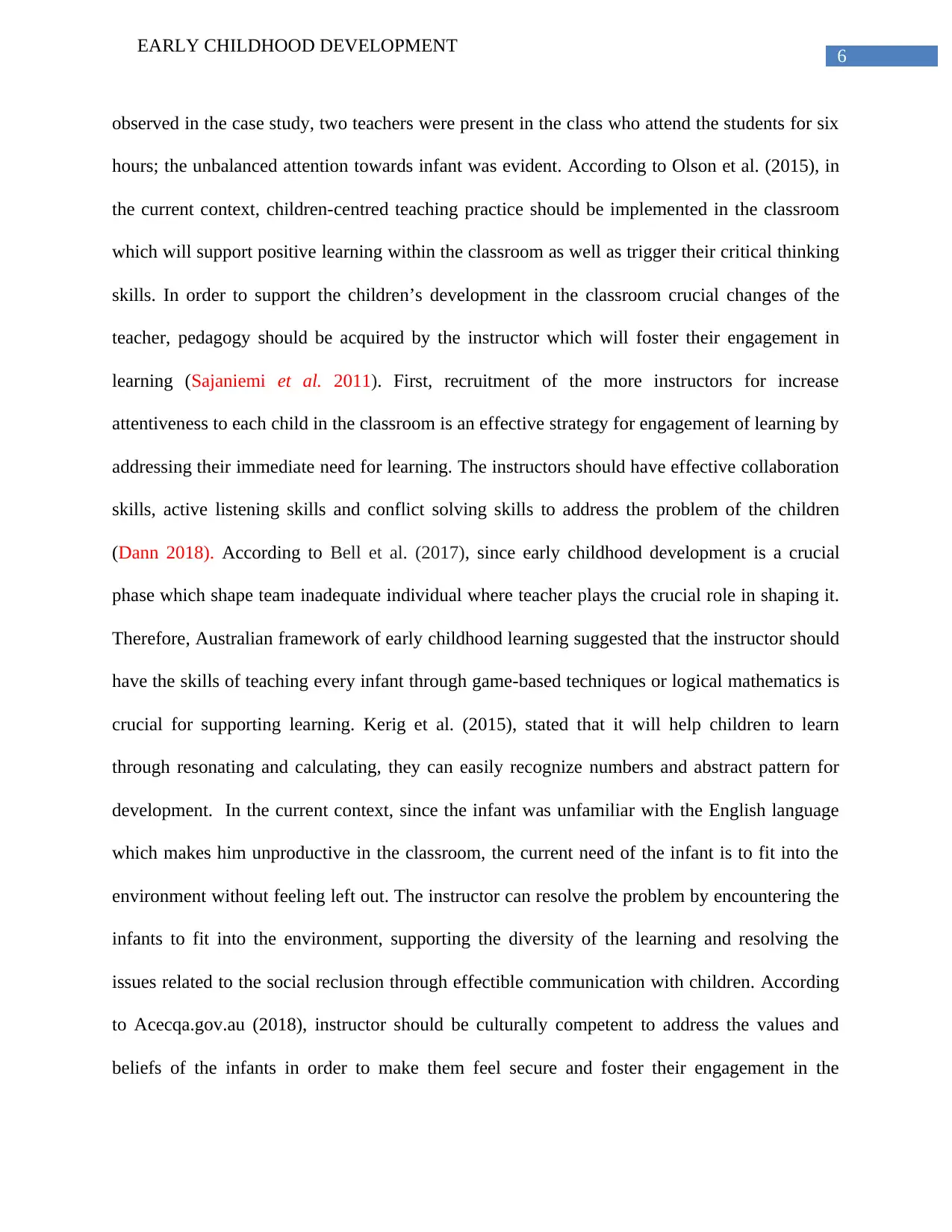
6
EARLY CHILDHOOD DEVELOPMENT
observed in the case study, two teachers were present in the class who attend the students for six
hours; the unbalanced attention towards infant was evident. According to Olson et al. (2015), in
the current context, children-centred teaching practice should be implemented in the classroom
which will support positive learning within the classroom as well as trigger their critical thinking
skills. In order to support the children’s development in the classroom crucial changes of the
teacher, pedagogy should be acquired by the instructor which will foster their engagement in
learning (Sajaniemi et al. 2011). First, recruitment of the more instructors for increase
attentiveness to each child in the classroom is an effective strategy for engagement of learning by
addressing their immediate need for learning. The instructors should have effective collaboration
skills, active listening skills and conflict solving skills to address the problem of the children
(Dann 2018). According to Bell et al. (2017), since early childhood development is a crucial
phase which shape team inadequate individual where teacher plays the crucial role in shaping it.
Therefore, Australian framework of early childhood learning suggested that the instructor should
have the skills of teaching every infant through game-based techniques or logical mathematics is
crucial for supporting learning. Kerig et al. (2015), stated that it will help children to learn
through resonating and calculating, they can easily recognize numbers and abstract pattern for
development. In the current context, since the infant was unfamiliar with the English language
which makes him unproductive in the classroom, the current need of the infant is to fit into the
environment without feeling left out. The instructor can resolve the problem by encountering the
infants to fit into the environment, supporting the diversity of the learning and resolving the
issues related to the social reclusion through effectible communication with children. According
to Acecqa.gov.au (2018), instructor should be culturally competent to address the values and
beliefs of the infants in order to make them feel secure and foster their engagement in the
EARLY CHILDHOOD DEVELOPMENT
observed in the case study, two teachers were present in the class who attend the students for six
hours; the unbalanced attention towards infant was evident. According to Olson et al. (2015), in
the current context, children-centred teaching practice should be implemented in the classroom
which will support positive learning within the classroom as well as trigger their critical thinking
skills. In order to support the children’s development in the classroom crucial changes of the
teacher, pedagogy should be acquired by the instructor which will foster their engagement in
learning (Sajaniemi et al. 2011). First, recruitment of the more instructors for increase
attentiveness to each child in the classroom is an effective strategy for engagement of learning by
addressing their immediate need for learning. The instructors should have effective collaboration
skills, active listening skills and conflict solving skills to address the problem of the children
(Dann 2018). According to Bell et al. (2017), since early childhood development is a crucial
phase which shape team inadequate individual where teacher plays the crucial role in shaping it.
Therefore, Australian framework of early childhood learning suggested that the instructor should
have the skills of teaching every infant through game-based techniques or logical mathematics is
crucial for supporting learning. Kerig et al. (2015), stated that it will help children to learn
through resonating and calculating, they can easily recognize numbers and abstract pattern for
development. In the current context, since the infant was unfamiliar with the English language
which makes him unproductive in the classroom, the current need of the infant is to fit into the
environment without feeling left out. The instructor can resolve the problem by encountering the
infants to fit into the environment, supporting the diversity of the learning and resolving the
issues related to the social reclusion through effectible communication with children. According
to Acecqa.gov.au (2018), instructor should be culturally competent to address the values and
beliefs of the infants in order to make them feel secure and foster their engagement in the
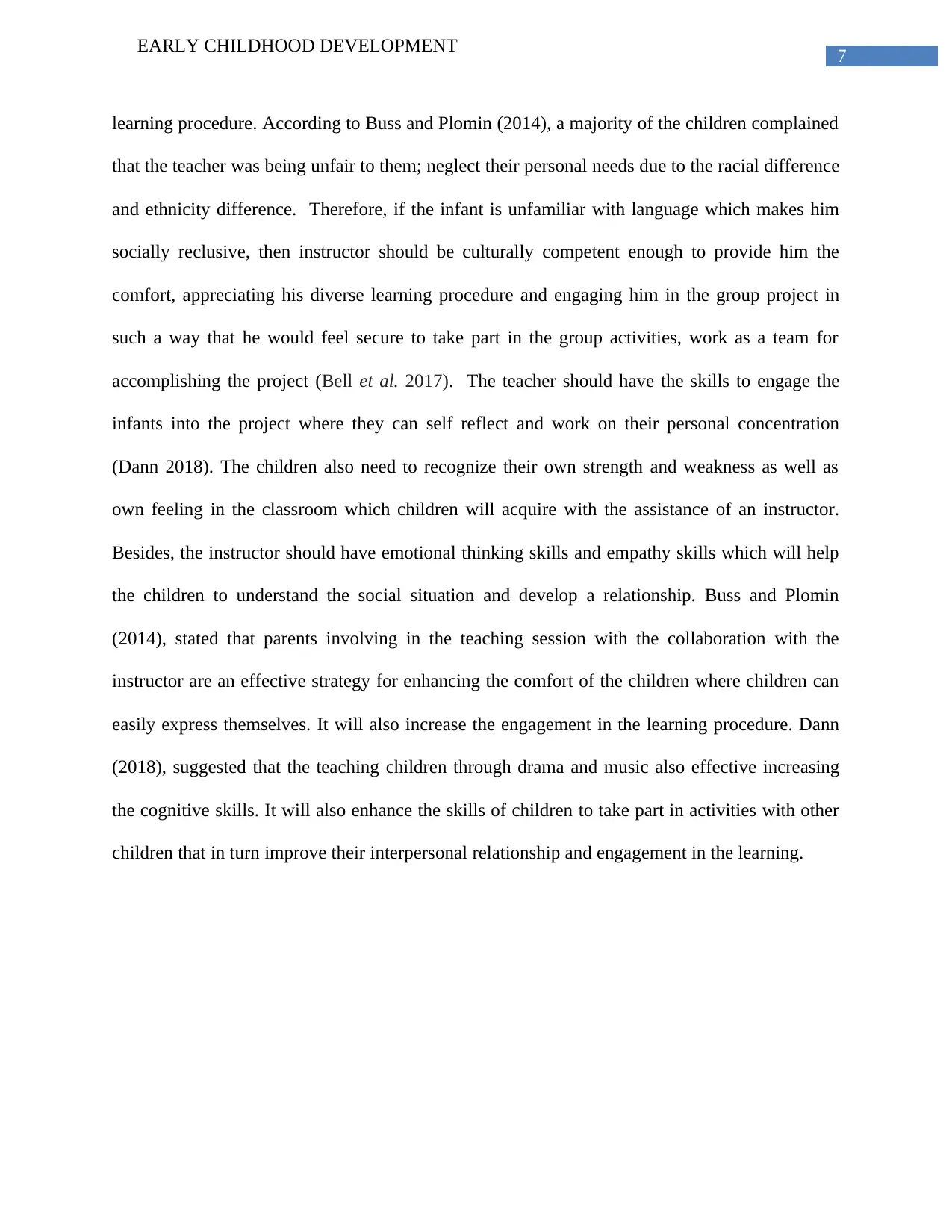
7
EARLY CHILDHOOD DEVELOPMENT
learning procedure. According to Buss and Plomin (2014), a majority of the children complained
that the teacher was being unfair to them; neglect their personal needs due to the racial difference
and ethnicity difference. Therefore, if the infant is unfamiliar with language which makes him
socially reclusive, then instructor should be culturally competent enough to provide him the
comfort, appreciating his diverse learning procedure and engaging him in the group project in
such a way that he would feel secure to take part in the group activities, work as a team for
accomplishing the project (Bell et al. 2017). The teacher should have the skills to engage the
infants into the project where they can self reflect and work on their personal concentration
(Dann 2018). The children also need to recognize their own strength and weakness as well as
own feeling in the classroom which children will acquire with the assistance of an instructor.
Besides, the instructor should have emotional thinking skills and empathy skills which will help
the children to understand the social situation and develop a relationship. Buss and Plomin
(2014), stated that parents involving in the teaching session with the collaboration with the
instructor are an effective strategy for enhancing the comfort of the children where children can
easily express themselves. It will also increase the engagement in the learning procedure. Dann
(2018), suggested that the teaching children through drama and music also effective increasing
the cognitive skills. It will also enhance the skills of children to take part in activities with other
children that in turn improve their interpersonal relationship and engagement in the learning.
EARLY CHILDHOOD DEVELOPMENT
learning procedure. According to Buss and Plomin (2014), a majority of the children complained
that the teacher was being unfair to them; neglect their personal needs due to the racial difference
and ethnicity difference. Therefore, if the infant is unfamiliar with language which makes him
socially reclusive, then instructor should be culturally competent enough to provide him the
comfort, appreciating his diverse learning procedure and engaging him in the group project in
such a way that he would feel secure to take part in the group activities, work as a team for
accomplishing the project (Bell et al. 2017). The teacher should have the skills to engage the
infants into the project where they can self reflect and work on their personal concentration
(Dann 2018). The children also need to recognize their own strength and weakness as well as
own feeling in the classroom which children will acquire with the assistance of an instructor.
Besides, the instructor should have emotional thinking skills and empathy skills which will help
the children to understand the social situation and develop a relationship. Buss and Plomin
(2014), stated that parents involving in the teaching session with the collaboration with the
instructor are an effective strategy for enhancing the comfort of the children where children can
easily express themselves. It will also increase the engagement in the learning procedure. Dann
(2018), suggested that the teaching children through drama and music also effective increasing
the cognitive skills. It will also enhance the skills of children to take part in activities with other
children that in turn improve their interpersonal relationship and engagement in the learning.
⊘ This is a preview!⊘
Do you want full access?
Subscribe today to unlock all pages.

Trusted by 1+ million students worldwide
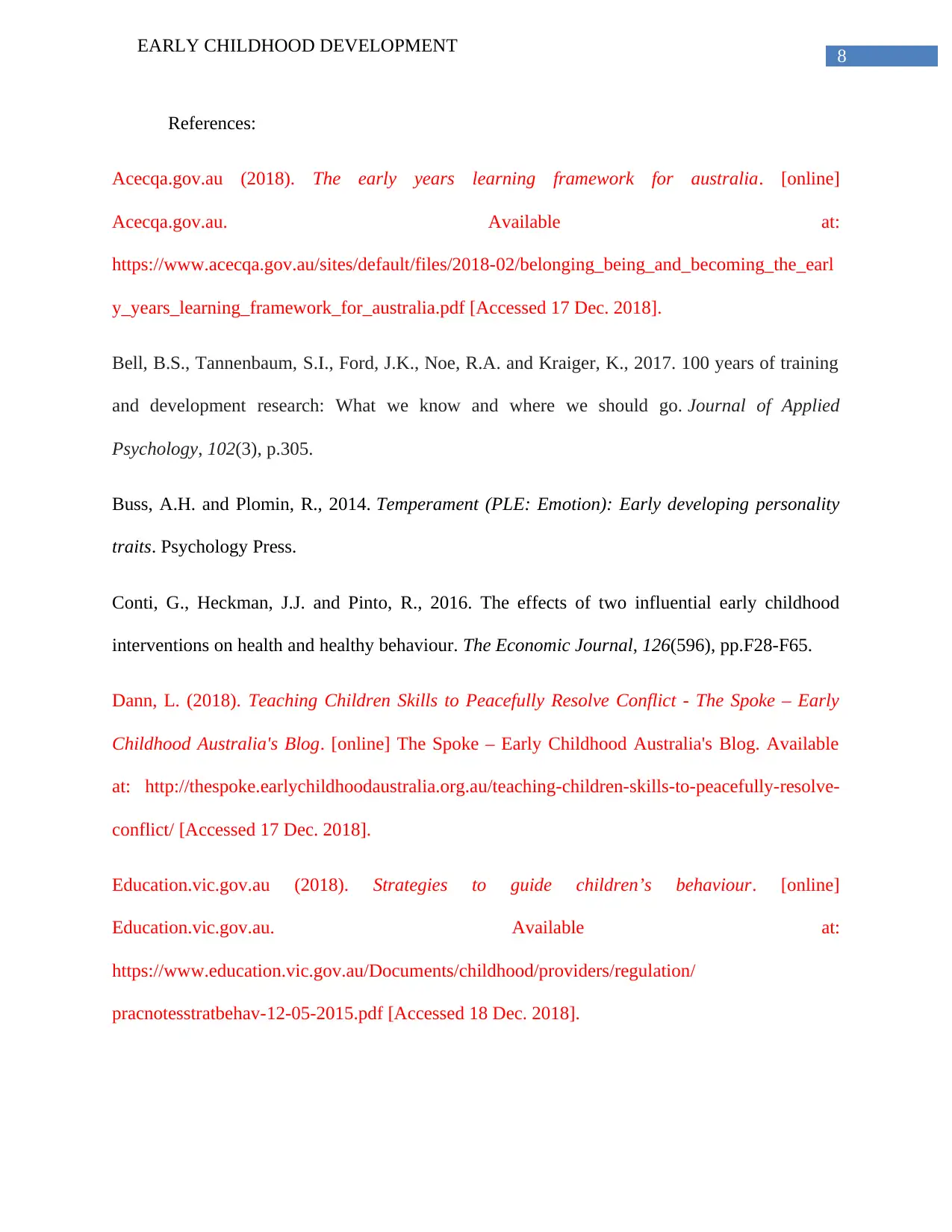
8
EARLY CHILDHOOD DEVELOPMENT
References:
Acecqa.gov.au (2018). The early years learning framework for australia. [online]
Acecqa.gov.au. Available at:
https://www.acecqa.gov.au/sites/default/files/2018-02/belonging_being_and_becoming_the_earl
y_years_learning_framework_for_australia.pdf [Accessed 17 Dec. 2018].
Bell, B.S., Tannenbaum, S.I., Ford, J.K., Noe, R.A. and Kraiger, K., 2017. 100 years of training
and development research: What we know and where we should go. Journal of Applied
Psychology, 102(3), p.305.
Buss, A.H. and Plomin, R., 2014. Temperament (PLE: Emotion): Early developing personality
traits. Psychology Press.
Conti, G., Heckman, J.J. and Pinto, R., 2016. The effects of two influential early childhood
interventions on health and healthy behaviour. The Economic Journal, 126(596), pp.F28-F65.
Dann, L. (2018). Teaching Children Skills to Peacefully Resolve Conflict - The Spoke – Early
Childhood Australia's Blog. [online] The Spoke – Early Childhood Australia's Blog. Available
at: http://thespoke.earlychildhoodaustralia.org.au/teaching-children-skills-to-peacefully-resolve-
conflict/ [Accessed 17 Dec. 2018].
Education.vic.gov.au (2018). Strategies to guide children’s behaviour. [online]
Education.vic.gov.au. Available at:
https://www.education.vic.gov.au/Documents/childhood/providers/regulation/
pracnotesstratbehav-12-05-2015.pdf [Accessed 18 Dec. 2018].
EARLY CHILDHOOD DEVELOPMENT
References:
Acecqa.gov.au (2018). The early years learning framework for australia. [online]
Acecqa.gov.au. Available at:
https://www.acecqa.gov.au/sites/default/files/2018-02/belonging_being_and_becoming_the_earl
y_years_learning_framework_for_australia.pdf [Accessed 17 Dec. 2018].
Bell, B.S., Tannenbaum, S.I., Ford, J.K., Noe, R.A. and Kraiger, K., 2017. 100 years of training
and development research: What we know and where we should go. Journal of Applied
Psychology, 102(3), p.305.
Buss, A.H. and Plomin, R., 2014. Temperament (PLE: Emotion): Early developing personality
traits. Psychology Press.
Conti, G., Heckman, J.J. and Pinto, R., 2016. The effects of two influential early childhood
interventions on health and healthy behaviour. The Economic Journal, 126(596), pp.F28-F65.
Dann, L. (2018). Teaching Children Skills to Peacefully Resolve Conflict - The Spoke – Early
Childhood Australia's Blog. [online] The Spoke – Early Childhood Australia's Blog. Available
at: http://thespoke.earlychildhoodaustralia.org.au/teaching-children-skills-to-peacefully-resolve-
conflict/ [Accessed 17 Dec. 2018].
Education.vic.gov.au (2018). Strategies to guide children’s behaviour. [online]
Education.vic.gov.au. Available at:
https://www.education.vic.gov.au/Documents/childhood/providers/regulation/
pracnotesstratbehav-12-05-2015.pdf [Accessed 18 Dec. 2018].
Paraphrase This Document
Need a fresh take? Get an instant paraphrase of this document with our AI Paraphraser

9
EARLY CHILDHOOD DEVELOPMENT
Hom, P.W., Lee, T.W., Shaw, J.D. and Hausknecht, J.P., 2017. One hundred years of employee
turnover theory and research. Journal of Applied Psychology, 102(3), p.530.
Justice, L.M., Logan, J.A., Lin, T.J. and Kaderavek, J.N., 2014. Peer effects in early childhood
education: Testing the assumptions of special-education inclusion. Psychological Science, 25(9),
pp.1722-1729.
Kauffman, J.M., Hallahan, D.P., Pullen, P.C. and Badar, J., 2018. Special education: What it is
and why we need it. Routledge.
Kerig, P.K. and Becker, S.P., 2015. 12 Early Abuse and Neglect as Risk Factors for the
Development of Criminal and Antisocial Behavior. In The development of criminal and
antisocial behavior (pp. 181-199). Springer, Cham.
Morgan, P.L., Farkas, G., Hillemeier, M.M., Mattison, R., Maczuga, S., Li, H. and Cook, M.,
2015. Minorities are disproportionately underrepresented in special education: Longitudinal
evidence across five disability conditions. Educational Researcher, 44(5), pp.278-292.
Olson, M.H., 2015. Introduction to theories of learning. Routledge.
Sajaniemi, N., Suhonen, E., Kontu, E., Rantanen, P., Lindholm, H., Hyttinen, S. and Hirvonen,
A., 2011. Children's cortisol patterns and the quality of the early learning environment. European
Early Childhood Education Research Journal, 19(1), pp.45-62.
Van Hoorn, J.L., Monighan-Nourot, P., Scales, B. and Alward, K.R., 2014. Play at the center of
the curriculum. Pearson.
EARLY CHILDHOOD DEVELOPMENT
Hom, P.W., Lee, T.W., Shaw, J.D. and Hausknecht, J.P., 2017. One hundred years of employee
turnover theory and research. Journal of Applied Psychology, 102(3), p.530.
Justice, L.M., Logan, J.A., Lin, T.J. and Kaderavek, J.N., 2014. Peer effects in early childhood
education: Testing the assumptions of special-education inclusion. Psychological Science, 25(9),
pp.1722-1729.
Kauffman, J.M., Hallahan, D.P., Pullen, P.C. and Badar, J., 2018. Special education: What it is
and why we need it. Routledge.
Kerig, P.K. and Becker, S.P., 2015. 12 Early Abuse and Neglect as Risk Factors for the
Development of Criminal and Antisocial Behavior. In The development of criminal and
antisocial behavior (pp. 181-199). Springer, Cham.
Morgan, P.L., Farkas, G., Hillemeier, M.M., Mattison, R., Maczuga, S., Li, H. and Cook, M.,
2015. Minorities are disproportionately underrepresented in special education: Longitudinal
evidence across five disability conditions. Educational Researcher, 44(5), pp.278-292.
Olson, M.H., 2015. Introduction to theories of learning. Routledge.
Sajaniemi, N., Suhonen, E., Kontu, E., Rantanen, P., Lindholm, H., Hyttinen, S. and Hirvonen,
A., 2011. Children's cortisol patterns and the quality of the early learning environment. European
Early Childhood Education Research Journal, 19(1), pp.45-62.
Van Hoorn, J.L., Monighan-Nourot, P., Scales, B. and Alward, K.R., 2014. Play at the center of
the curriculum. Pearson.
1 out of 8
Related Documents
Your All-in-One AI-Powered Toolkit for Academic Success.
+13062052269
info@desklib.com
Available 24*7 on WhatsApp / Email
![[object Object]](/_next/static/media/star-bottom.7253800d.svg)
Unlock your academic potential
Copyright © 2020–2025 A2Z Services. All Rights Reserved. Developed and managed by ZUCOL.





